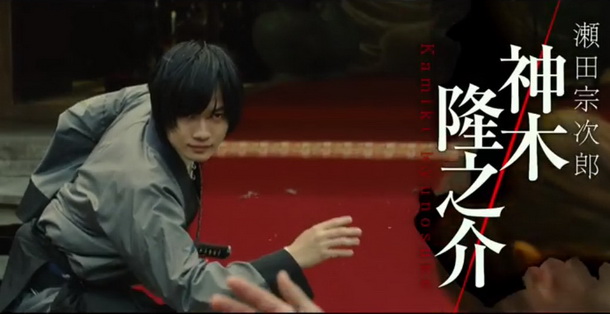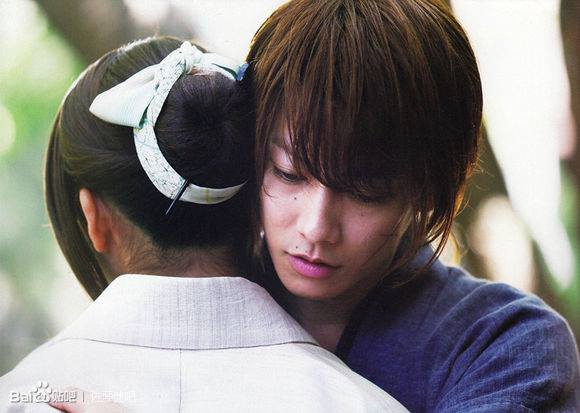Kenshin Himura sets the silver screen ablaze again.
Forgive the pun. Can’t help it. That statement was one of the many things scrambling about inside my head after 2+ hours of glorious samurai legend story telling. The second installment of this much-awaited three-part saga, Rurouni Kenshin: Kyoto Inferno delivered exactly what its predecessor promised, plus more tricks and twists care of director Keishi Otomo‘s artistic madness.
Let’s break it down.
Shishio and his mad theatrics. I’ve been deathly afraid of Shishio since I first met him in the anime. He was the personification of the worst villain: a betrayed, bitter, skilled and charismatic megalomaniac believing he is saving the world. His burned skin under the stylish bandages and royal robes completed the menacing glow, punctuated by his manic smile. Tatsuya Fujiwara as Shishio magnified that evil and brought it to full theatrics on screen, maybe thanks to having had enough practice playing the silently psychotic Light Yagami in Death Note.
The film opens with Shishio in his lair-of-the-moment, surrounded by flames, sword in hand, his deadly Juppongatana in line behind him. He flashes his teeth as the drums build to a deafening sound. Here comes trouble indeed.
Sojiro Seta. Kyoto Inferno introduced a lot of new characters, and I have my beef and my raves over each one, from Cho the sword collector, to Okina and Misao of the Oniwabanshu. The one I was most invested in though was Shishio’s favorite guard, Sojiro Seta. My sister did not think Ryunosuke Kamiki was epicene enough to play the emotionless killer child. But what the boy lacked (by little in my opinion) in effeminate charms, he made up with understated yet intense acting. The first time he smiled sent chills down my spine. His first duel with Kenshin was nothing short of epic, a teasing slice of more legendary fight scenes to come.
Movie vs manga. Director Otomo braved to take on more creative license this time around, daring to veer away from the bible word of creator Nobuhiro Watsuki‘s manga in some very important plot points. Huge props for him for not making Kaoru an emotional wreck after Kenshin said goodbye, a refreshing change from the depressed Kaoru in the manga. Emi Takei was given free leave to play an independent, spirited Kaoru, and she did so with elegant maturity.
That goodbye scene though was understandably the topic of much discussion. In the anime, the scene was set at night against the dramatic backdrop of fireflies, with Kaoru (and invested viewers) dropping to her knees and shedding droplets of tears after Kenshin embraced her goodbye. Fans (hand raised!) were all aching for this beautiful scene come to life, tears at the ready. But Otomo decided otherwise, probably combining inspiration from the anime and the manga. In the original text, this scene did happen at night, but with fallen leaves dancing around instead of fireflies. Otomo deleted the fireflies, kept the leaves and the road, but kept the sun’s light, depicting a muted, beautiful setting, letting the actors’ chemistry carry the weight of the goodbye. I believe it was still a score. Tears still fell.
My beef is in the underdeveloped Aoishi Shinomori plot line. Since his Oniwabanshu was not credited for the villany in the first film, Aoshi’s back story felt a little forced. Thus his extreme animosity toward Kenshin bordered on unfounded transitivity of blame and just plain psychosis. I’m giving this one another shot when the third and final movie comes, hoping Aoshi is given the live action justice he deserves.
Then there is that massive plot twist in the final scenes, making the manga and anime fan audience grip their seats with “WTF” screaming inside their heads. One because it is quite an intense turn of events, but mostly because that was not in the original material at all. And now the know-it-alls/die-hard fans are as clueless to the plot as the Samurai X newbies.
The Kyoto arc is arguably the richest and most dramatic plots in the Kenshin Himura story. In that story line, Kenshin has retired from being a wanderer. He has taken tentative steps towards building a home, gaining friends, and hopefully forgiving himself enough to believe that he deserves happiness. In the middle of this peace he is again taunted by his past, called upon to revert to the killer he vowed he never will be again. Kyoto Inferno was able to bring all this drama to life through an elegant weave of stunning fight scenes, graceful cinematography and sincere acting. Takeru Sato, Takei, Munetaka Aoki (Sanosuke), Yu Aoi (Megumi) and Yosuke Eguchi (Saito Hajime) have settled comfortably into their characters, and their understanding of their roles is palpable in every scene.
Watch the movie and be ready to grip your seat. Afterwards you will want to watch the trailer for the final installment, Rurouni Kenshin: The Legend Ends below. Trust me.
Photo and video credits to owners.










Review: Rurouni Kenshin The Legend Ends | Daydreaming since 1985. Sometimes with actual results.
October 15, 2014 at 10:04 pm[…] no matter how much fans wanted to deny it. As the movies from the franchise kept coming out better and stronger than the last, it was hard to accept an end to such deliciously addictive samurai live action/full […]
Review: Lupin III | Daydreaming since 1985. Sometimes with actual results.
December 8, 2014 at 9:41 am[…] it is because I watched Lupin III in the midst of the sheer glory of the Rurouni Kenshin trilogy. Maybe it is because I haven’t met a multi-language movie that I liked. Or maybe because this […]